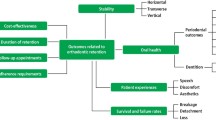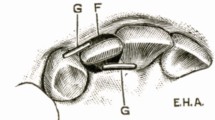Abstract
Careful orthodontic treatment planning should involve the delineation of clear treatment objectives within each dental arch. Treatment planning decisions are underpinned by aesthetic goals, dental health considerations and the prospect of stability, with these factors often competing. There is also a near-universal acceptance of the requirement for some form of retention. A novel hierarchy of orthodontic stability is proposed. As further evidence emerges and technical refinement continues, it is likely that this will undergo further adaptation. Ultimately, however, this knowledge will ensure that our understanding of the merits of orthodontic intervention, allied to the burden of retention, can be clearly presented to prospective orthodontic patients.
Key points
-
There is a key interplay between often competing occlusal, functional and aesthetic goals during orthodontics.
-
A novel hierarchy of orthodontic stability accounting for contemporary approaches to retention is proposed.
-
This hierarchy will be subject to adaptation but should underpin our understanding of the merits of orthodontic intervention, allied to the burden of retention, and therefore could be integral both to planning decisions and decision-making.
This is a preview of subscription content, access via your institution
Access options
Subscribe to this journal
Receive 24 print issues and online access
$259.00 per year
only $10.79 per issue
Buy this article
- Purchase on Springer Link
- Instant access to full article PDF
Prices may be subject to local taxes which are calculated during checkout





Similar content being viewed by others
References
Fleming P S, Fedorowicz Z, Johal A, El-Angbawi A, Pandis N. Surgical adjunctive procedures for accelerating orthodontic treatment. Cochrane Database Syst Rev 2015; DOI: 10.1002/14651858.CD010572.pub2.
DiBiase A T, Woodhouse N R, Papageorgiou S N et al. Effects of supplemental vibrational force on space closure, treatment duration, and occlusal outcome: A multicentre randomized clinical trial. Am J Orthod Dentofacial Orthop 2018; DOI: 10.1016/j.ajodo.2017.10.021.
Ackerman J L, Proffit W R, Sarver D M. The emerging soft tissue paradigm in orthodontic diagnosis and treatment planning. Clin Orthod Res 1999; 2: 49-52.
Mills J R. The stability of the lower labial segment. A cephalometric survey. Dent Pract Dent Rec 1968; 18: 293-306.
Williams P. Lower incisor position in treatment planning. Br J Orthod 1986; 13: 33-41.
Sinclair P M, Little R M. Maturation of untreated normal occlusions. Am J Orthod 1983; 83: 114-123.
Javidi H, Vettore M, Benson P E. Does orthodontic treatment before the age of 18 years improve oral health-related quality of life? A systematic review and meta-analysis. Am J Orthod Dentofacial Orthop 2017; 151: 644-655.
Seehra J, Fleming P S, Newton T, DiBiase A T. Bullying in orthodontic patients and its relationship to malocclusion, self-esteem and oral health-related quality of life. J Orthod 2011; 38: 247-294.
Seehra J, Newton J T, Dibiase A T. Interceptive orthodontic treatment in bullied adolescents and its impact on self-esteem and oral-health-related quality of life. Eur J Orthod 2013; 35: 615-621.
Fleming P S, Springate S D, Chate R A. Myths and realities in orthodontics. Br Dent J 2015; 218: 105-110.
Alkadhi R M, Finkelman M D, Trotman C A, Kanavakis G. The role of lip thickness in upper lip response to sagittal change of incisor position. Orthod Craniofac Res 2019; 22: 53-57.
Eberhart B B, Kuftinec M M, Baker I M. The relationship between bite depth and incisor angular change. Angle Orthod 1990; 60: 55-58.
Ackerman J L, Proffit W R. Soft tissue limitations in orthodontics: treatment planning guidelines. Angle Orthod 1997; 67: 327-336.
Melsen B, Allais D. Factors of importance for the development of dehiscences during labial movement of mandibular incisors: a retrospective study of adult orthodontic patients. Am J Orthod Dentofacial Orthop 2005; 127: 552-625.
Bassarelli T, Melsen B. Expansion: how much can the periodontium tolerate? Clin Orthod Res 2001; 4: 235-241.
Little R M. Clinical implications of the University of Washington post-retention studies. J Clin Orthod 2009; 43: 645-651.
Sullivan T C, Turpin D L, Artun J. A postretention study of patients presenting with a maxillary median diastema. Angle Orthod 1996; 66: 131-138.
Aasen T O, Espeland L. An approach to maintain orthodontic alignment of lower incisors without the use of retainers. Eur J Orthod 2005; 27: 209-214.
Naraghi S, Ganzer N, Bondemark L, Sonesson M. Comparison of post-treatment changes with and without retention in adolescents treated for maxillary impacted canines-a randomized controlled trial. Eur J Orthod 2020; DOI: 10.1093/ejo/cjaa010.
Proffit W R, Turvey T A, Phillips C. The hierarchy of stability and predictability in orthognathic surgery with rigid fixation: an update and extension. Head Face Med 2007; 3: 21.
Oliver G R, Pandis N, Fleming P S. A prospective evaluation of factors affecting occlusal stability of Class II correction with Twin-block followed by fixed appliances. Am J Orthod Dentofacial Orthop 2020; 157: 35-41.
Pancherz H, Bjerklin K, Lindskog-Stokland B, Hansen K. Thirty-two-year follow-up study of Herbst therapy: a biometric dental cast analysis. Am J Orthod Dentofacial Orthop 2014; 145: 15-27.
Yoshizumi J, Sueishi K. Post-treatment Stability in Angle Class III Cases. Bull Tokyo Dent Coll 2016; 57: 29-35.
Kim T W, Little R M. Postretention assessment of deep overbite correction in Class II Division 2 malocclusion. Angle Orthod 1999; 69: 175-186.
Schütz-Fransson U, Bjerklin K, Lindsten R. Long-term follow-up of orthodontically treated deep bite patients. Eur J Orthod 2006; 28: 503-512.
Scheffler N R, Proffit W R, Phillips C. Outcomes and stability in patients with anterior open bite and long anterior face height treated with temporary anchorage devices and a maxillary intrusion splint. Am J Orthod Dentofacial Orthop 2014; 146: 594-602.
Zuccati G, Casci S, Doldo T, Clauser C. Expansion of maxillary arches with crossbite: a systematic review of RCTs in the last 12 years. Eur J Orthod 2013; 35: 29-37.
Steinnes J, Johnsen G, Kerosuo H. Stability of orthodontic treatment outcome in relation to retention status: An 8-year follow-up. Am J Orthod Dentofacial Orthop 2017; 151: 1027-1033.
Author information
Authors and Affiliations
Corresponding author
Ethics declarations
The author declares no conflicts of interest.
Rights and permissions
About this article
Cite this article
Fleming, P. Orthodontic treatment planning: can we plan for stability?. Br Dent J 230, 717–721 (2021). https://doi.org/10.1038/s41415-021-2891-5
Received:
Accepted:
Published:
Issue Date:
DOI: https://doi.org/10.1038/s41415-021-2891-5
This article is cited by
-
Five tips for orthodontic practitioners
British Dental Journal (2021)



